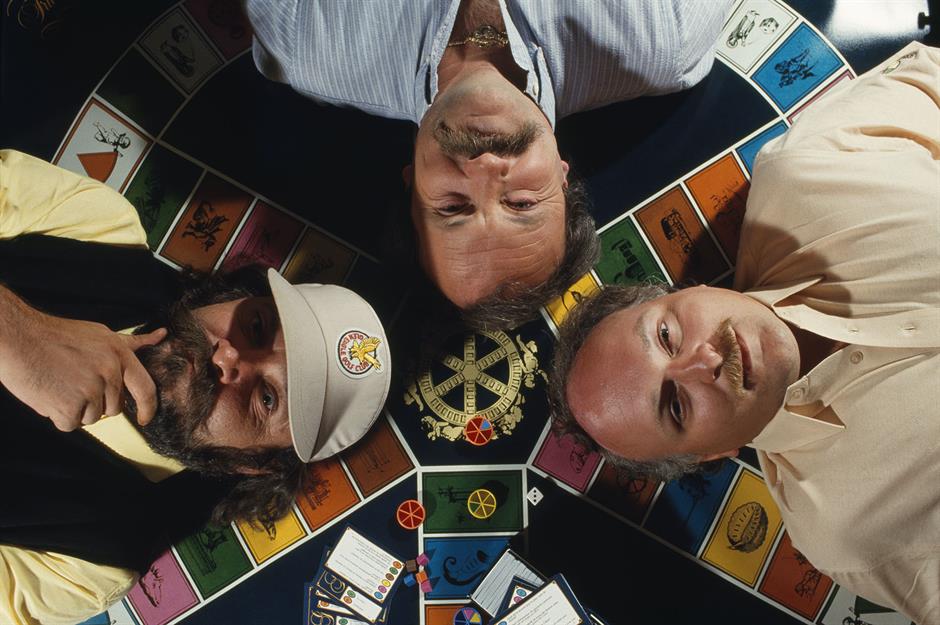Canadian products that changed the world, from batteries to the Blackberry
Ingenious inventions from the Great White North
What have sunglasses and chewing gum got in common? They were both invented in Canada, of course.
Looking back through the North American nation's history, read on as we reveal some of the most awesome innovations to have come out of Canada. Some might just surprise you...
Kayak (up to 5,000 years ago)
The Inuit, Yupik and Aleut people were the first to use kayaks, which are estimated to have been invented up to 5,000 years ago. The word kayak derives from the Inuit "qayag."
The compact boats were originally made from stitched animal skins stretched over a frame constructed from wood or whalebone, though wood was also used to an extent.
Toboggan (many centuries ago)
The world owes a huge debt of gratitude to Canada's First Nations people, who pioneered a number of innovations we still value today.
These include the versatile toboggan, the wood sled used to transport goods and people over snow and ice.
Sunglasses (many centuries ago)
The precursors to modern sunglasses were also invented by First Nations people, namely the Inuit and the Yupik.
For centuries, they've fashioned snow goggles from various materials including spruce driftwood, walrus ivory, bone, and caribou antlers to protect against snow blindness.
Petroleum jelly (many centuries ago)
Vaseline may have been officially discovered in 1859 by American chemist Robert Chesebrough and patented in 1872, but Canada's First Nations had been making their very own petroleum jelly concoction for centuries by blending olefin hydrocarbons and methane.
The mixture is used to moisturize skin and condition animal hides.
Parka (many centuries ago)
Canada is renowned for its cosy parka jackets with brands like Canada Goose popular throughout the world.
While the word parka derives from an Aleutian moniker for "animal skin," the garment was invented by the Inuit people and has been worn throughout the Arctic regions of North America for centuries.
Chewing gum (many centuries ago)
You may think of chewing gum as a modern invention, but the first chewable gum products were actually created by First Nations people living in Canada many centuries ago.
They used the gum-like resin of the spruce tree for medicinal purposes, including to ease toothache.
Steam fog horn (1853/1854)
Conceived by Scottish-born Canadian Robert Foulis in either 1853 or 1854, the first steam-powered fog horn was installed on New Brunswick's Partridge Island in 1859.
Foulis was inspired to create the warning device after reading about a shipwreck off the Newfoundland coast. His invention has undoubtedly saved an untold number of lives around the world.
Light bulb (1874)
America's Thomas Edison is widely credited with inventing the first commercial incandescent light bulb, but much of the know-how behind his innovation came from two Toronto inventors: Woodward and Matthew Evans.
The duo filed a patent for an electric lamp in 1874 but failed to bring the technology to market. They ended up selling their patent to Edison in 1879, and the rest is history.
Telephone (1876)
Debate rages over whether the telephone is a British, American, or Canadian invention. What is certain is that Scottish-born Canadian resident Alexander Graham Bell came up with his idea for the game-changing mode of communication while observing currents beside Ontario's Grand River.
Although the patent was eventually filed in the US, Bell didn't become an American citizen until 1882.
Electric oven (1882)
Wowing his dinner guests, Ottawan engineer Thomas Ahearn scored a world-first in 1882 when he cooked a meal in an electric range he had developed in secret.
The technology was brought to market a decade later when the first commercial electric oven was installed in the Canadian capital's Windsor Hotel.
Peanut butter (1884)
American George Washington Carver is often thought of as the originator of peanut butter, but like so many innovations credited to US inventors, the spread was actually conceived by a Canadian (though the Ancient Incas and Aztecs made similar concoctions).
Montreal's Marcellus Gilmore Edson was issued the first patent for the nutty paste back in 1884.
Caulking gun (1894)
Used to seal cracks and weatherproof windows and doors, among other things, the caulking gun is an indispensable professional and DIY tool.
The device was invented in 1894 by Theodore Witte of Chilliwack, British Columbia who's believed to have taken inspiration from a baker decorating a cake with an icing bag.
Bi-pin connector (1894)
Canada's next big contribution to lighting came in 1894 with the invention of the bi-pin connector, which was created by Québécois innovator Reginald Fessenden for the 1893 World's Fair in Chicago. After being awarded the contract to light the Fair, Fessenden decided to use alternating current rather than the direct current pioneered by Thomas Edison.
Feeling slighted, Edison wouldn't allow Fessenden to use his patented screw light bulbs, and so the bi-pin alternative was invented. The lamp fitting is still widely used today around the world.
Egg carton (1911)
This packaging essential was invented in 1911 by newspaper publisher Joseph Coyle in Smithers, British Columbia after he witnessed an argument between a farmer and hotelier, who bemoaned that many of the eggs delivered to the hotel arrived broken.
Coyle vowed to find a solution and designed the carton we're familiar with today.
Zipper (1914)
Electrical engineer Gideon Sundbäck was working for the Universal Fastener Company in St. Catharines, Ontario when he came up with the idea for the “Hookless Number 1.”
The Swedish-born innovator went on to refine his design and created the first modern zipper, which he patented in 1914.
Insulin (1921)
Voted the greatest Canadian invention by the nation's public for the 2007 TV show of the same name, insulin was discovered in 1921 by Charles Herbert Best and Frederick Banting in the laboratory of John Macleod at the University of Toronto.
The peptide hormone provided a lifeline for type 1 diabetes sufferers, most of who lived for little more than a year or two before its sensational discovery.
Snowmobile (1922)
Canada is practically synonymous with snow and boasts some of the snowiest places in the world, including St. John's and Québec City. It comes as no surprise, then, that the nation is the birthplace of the snowmobile.
The motorized sled was invented in 1922 by 15-year-old Joseph-Armand Bombardier and eventually patented and commercialized in 1937.
Snow blower (1925)
Another snow-conquering contraption conceived by a Canadian, the snow blower was invented in 1925 by Québécois Arthur Sicard, a milkman who'd had enough of climbing over huge snowbanks to deliver his wares.
Sicard set his mind to creating a machine that could easily clear snow and didn't disappoint, putting his device on the market in 1927.
Walkie-talkie (1937)
The handheld two-way radio receiver was extensively developed during the Second World War by engineers from a number of countries.
But the first true walkie-talkie was invented in 1937 in Ottawa by British-born engineer Donald Hings, who created the device for his employer CM&S.
Paint roller (1940)
Professional decorators and DIY-ers the world over have Toronto's Norman Breakey to thank for inventing the paint roller, the time-saving marvel that almost guarantees the smoothest of paint finishes.
Sadly, Breakey failed to patent his innovation and was pipped to the post by American Richard Croxton Adams, who registered a rival design.
G-suit (1941)
G-suits protect aviators and astronauts from powerful g-forces that could otherwise kill them. The first anti-gravity suit was developed in 1941 by a team led by Wilbur R Franks at the University of Toronto's Banting and Best Medical Institute.
The so-called Franks Flying Suit was used operationally the following year, and the technology ultimately proved crucial for the US space program.
Pager (1949)
Back in the late 1980s and early 1990s, cell phones tended to be the preserve of hotshot executives while everyone else, particularly in North America, relied on pagers.
Patented in 1949 by Ontario-born telephony pioneer Al Gross, the clever little communication gizmo was first used in New York City's Jewish Hospital.
Garbage bag (1950s)
During the 1950s three Canadian inventors, Frank Plomp, Harry Wasylyk, and Larry Hansen, each created their own versions of the now-ubiquitous plastic garbage bag.
Although the innovation isn't the most environmentally friendly by a long shot, it has improved the hygiene of refuse collection immeasurably.
Electric wheelchair (1953)
One of Canada's most prolific inventors, Ontario-born George Klein brought the world everything from aircraft skis to the microsurgical staple gun.
However, he's best remembered for creating the world's first motorized wheelchair, an invention that has massively improved the lives of countless people worldwide.
Alkaline battery (1954)
The modern long-life alkaline battery, which has made possible a plethora of portable devices from electric razors to cameras, was invented in 1954 by Canadian scientist Lewis Urry, who was something of a battery pioneer.
Urry is also credited with inventing the lithium battery, which powers modern tools such as smartphones, laptops, and electric cars.
IMAX (1968)
The world's most immersive cinema experience was conceived in 1968 by Canadian filmmakers Graeme Ferguson, Roman Kroitor, and Robert Kerr, together with engineer William Shaw.
The filmmaking trio was hired to create a multiscreen movie at Montréal's Expo 67 and used multiple projectors to do the job. With Shaw's assistance, the technology was refined into a single projector the following year, and IMAX was born.
Electric prosthetic hand (1971)
A Canadian invention that has brought mobility and freedom back into the lives of amputees around the world, the electric prosthetic hand was created in 1971 by medical scientist Helmut Lucas.
It was the first of its kind to be controlled by signals from the wearer's muscles and nervous system.
Trivial Pursuit (1979)
Dubbed "the biggest phenomenon in game history" by Time magazine, the general knowledge board game Trivial Pursuit was devised in 1979 by Canadian journalists Chris Haney and Scott Abbott (pictured here with a third unnamed person), who dreamed up the pastime while playing a game of Scrabble.
Trivial Pursuit fast became a global success and has since sold millions of copies worldwide.
BlackBerry (1999)
Today's smartphones are majorly influenced by the iconic BlackBerry, which launched in 1999 and enticed business customers with its wireless email and internet access. An unputdownable device, the gadget was nicknamed the "CrackBerry" due to its addictiveness.
Lovers of the gizmo have Turkish-born Canadian Mike Lazaridis to thank for bringing the BlackBerry to market.
Now discover 20 ridiculed inventions that changed the world

